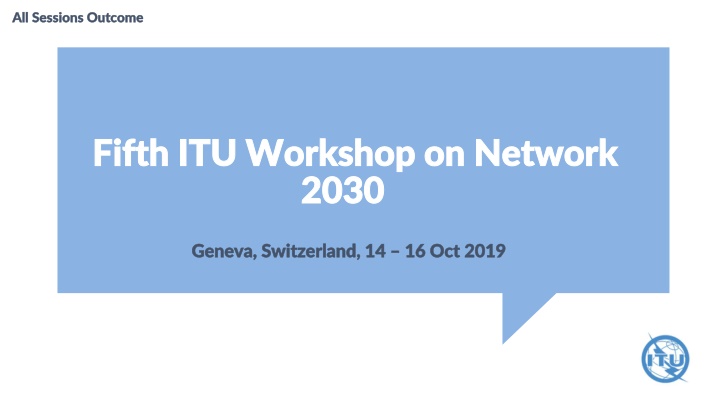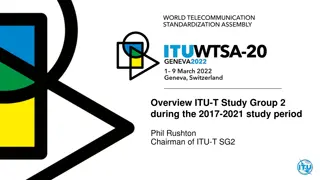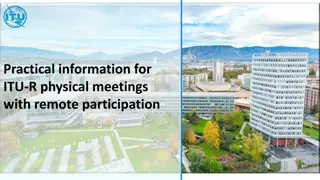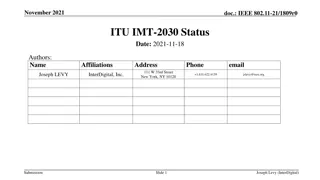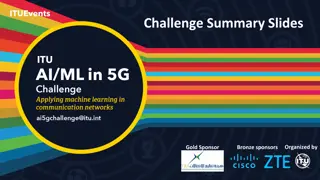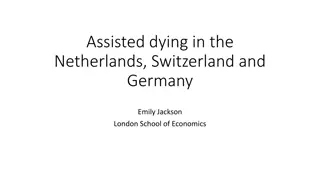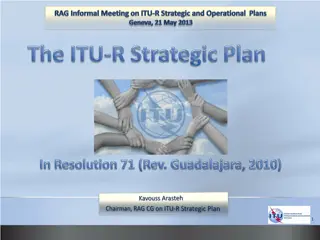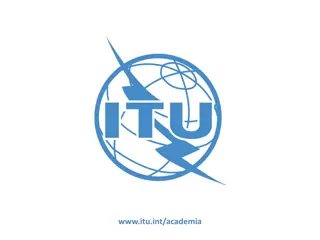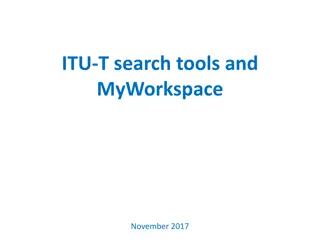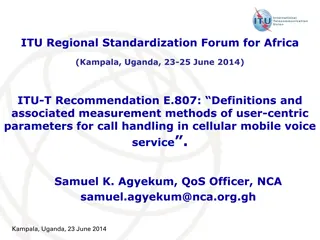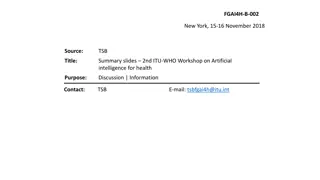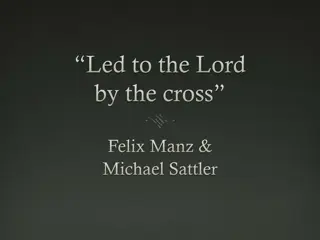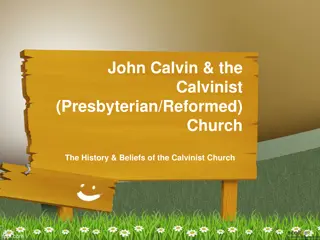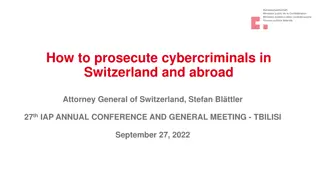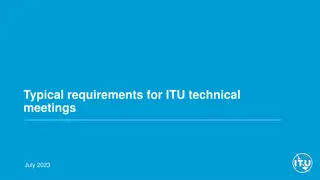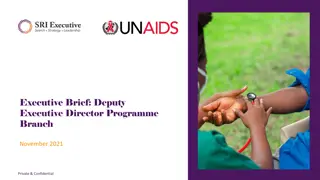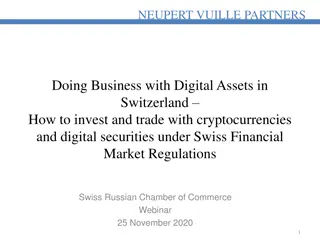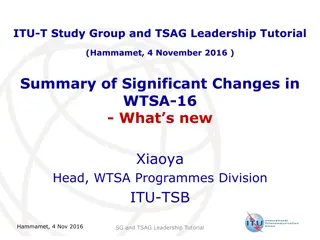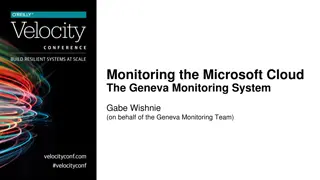Insights from Fifth ITU Workshop on Network 2030 in Geneva, Switzerland
Key takeaways and conclusions from the Fifth ITU Workshop on Network 2030 in Geneva, Switzerland included discussions on self-driving networks, new technologies, and intent-based networking. Topics such as evolving the management plane, incorporating ML5G work, and the importance of Intent-Based Networking for managing network complexity were highlighted. The workshop emphasized the need for advancements in network technologies to meet the demands of the future.
Download Presentation

Please find below an Image/Link to download the presentation.
The content on the website is provided AS IS for your information and personal use only. It may not be sold, licensed, or shared on other websites without obtaining consent from the author.If you encounter any issues during the download, it is possible that the publisher has removed the file from their server.
You are allowed to download the files provided on this website for personal or commercial use, subject to the condition that they are used lawfully. All files are the property of their respective owners.
The content on the website is provided AS IS for your information and personal use only. It may not be sold, licensed, or shared on other websites without obtaining consent from the author.
E N D
Presentation Transcript
All Sessions Outcome All Sessions Outcome Fifth ITU Workshop on Network Fifth ITU Workshop on Network 2030 2030 Geneva, Switzerland, Geneva, Switzerland, 14 14 16 Oct 2019 16 Oct 2019
Session 1: Keynote Session 1 Session 1: Keynote Session 1- - Self Self- -Driving Networks Driving Networks Takeaways and Conclusions Takeaways and Conclusions Suggestions to FG NET2030 Suggestions to FG NET2030 Evolve management plane with data and control plane, not as an afterthought consider management plane and manageability as part of FG NET2030 scope Consider architecture around a version of an OODA control loop Observe/Orient/Decide/Act Self-managed SLAs for Network 2030 services an important use case to consider 1. Self-Driving Networks can be as disruptive to networking as self-driving cars can be to the automotive industry Free up people from mundane tasks to work on a higher level, unleashing creation of new services while enabling greater network security Need to transition through multiple stages current state-of-the art is at stage 2 or 3 of 5 Machine Learning, Telemetry, Intent, and Rule-Based systems will all likely be part of a solution One barrier is instinctive hesitation to give up control needs to occur gradually to gain confidence and earn user s trust 2. 3. 4. 5.
Session 2: Session 2: New Technologies I New Technologies I Takeaways and Conclusions Takeaways and Conclusions 1. We need to pay attention to ML5G work for 5G access network to see if we can use their work for the Access Network in our architecture. 2. We need to look into ETSI ENI specs to see if we can use it in our management architecture. 3. Network Programmability in FGNET2030 has been emphasized. We agree with it.
Session 3: Session 3: Keynote Session II: Intent Keynote Session II: Intent- -Based Networking Based Networking Takeaways and Conclusions Takeaways and Conclusions Suggestions to FG NET2030 Suggestions to FG NET2030 Consider IBN as a key component of Network 2030 Management Plane 1. Intent-Based Networking is an important technique to keep abreast of network complexity and scale Define what Intent use cases in the context of Network 2030 services and infrastructure (expected to be significantly more complex than Data Center 2. IBN allows users to define desired outcomes ( what ), not how to reach them 3. Data Center use cases are a good starting point; Take entire intent lifecycle into consideration monitoring compliance with intent once it is defined Functional (De-)Composition is key 4. IETF has started standardization of key concepts 5. Intent-Based Monitoring and Analytics are just as important as configuration activities; graph traversal and telemetry are key for generating actionable insights
Session 4: Session 4: New Technologies II New Technologies II Takeaways and Conclusions Takeaways and Conclusions Suggestions to FG NET2030 Suggestions to FG NET2030 Consider new IP technologies in network 2030 including 1. New IP provide new connecting and capability for Network the capabilities of deterministic forwarding, 2030, which includes deterministic forwarding, interconnection manynets, instinct security, flexible interconnection manynets, instinct security. address space. 2. A two-tier 360 video streaming framework with user Field- A two-tier 360 video streaming framework with user of-View prediction and prioritized buffer control is proposed Field-of-View prediction and prioritized buffer control is to effectively accommodate the dynamics in both network bandwidth and user viewing direction. proposed to consider in network 2030 technology. 3. Holographic media building blocks include packetization, Holographic media transport technologies including High precondition, qualitative, coordinated. Future media packetization, High precondition, qualitative, support multi sensory for spatial compute ,teleportation etc. coordinated etc. should to consider in network 2030. 4. Services and the network are intrinsically linked. Use of BPP Service transport mechanism should aware need applications aware of BPP's behavior, and construct packets with the correct structure etc. transportation layer technologies
Session 5: Session 5: Service Provider 1 Service Provider 1 Takeaways and Conclusions Takeaways and Conclusions 1. Edge application requires flexible computing scheduling crossing edge cloud 2. 3. 4. Build a computing scheduling solution based on cloud, network and edge deeply collaboration. More base stations are needed to accommodate short range connectivity Higher frequencies do not propagate through walls, as a result, base stations must be installed indoors 5. 6. Spectrum regulation has to enable local frequency licensing for the benefit of different verticals Virtual and micro operators are expected to enter into the 5G market where a virtual operator does not have own infrastructure but has own customer base, and a micro operator (uO) has own infrastructure but not necessarily own customer base.
Session 6: Session 6: Service Provider 2 Service Provider 2 Takeaways and Conclusions Takeaways and Conclusions Suggestions to FG NET2030 Suggestions to FG NET2030 Consider use cases, required technologies, etc. based on these future network direction. 1. Future network will incorporate AI, all light network, various kinds of network access and lightweight core network equipment. Consider future network use cases that assume the realization of ultra high dense network. 2. Technologies for ultra high dense and ultra low latency will be realized. Consider use cases, required technologies, etc. using a THz network and its advantages. 3. THz technologies are becoming mature and will be used for communications. The THz network has several advantages, such as ultra high bandwidth, ultra low latency, cell-less network, etc.
Session 7: New Technologies 3 Session 7: New Technologies 3 Suggestions to FG NET2030 Suggestions to FG NET2030 Takeaways and Conclusions Takeaways and Conclusions Consider: 1. Integration of GEO/LEO satellite communications with emerging terrestrial network systems, such as 5G, can offer How to overcome and incorporate the challenges related to satellite multiple benefits to fill gaps that other networks can t fill. networks to get the most out of the technology to realise the These benefits include: coverage in isolated areas; benefits. deployment on-demand (e.g. disaster recovery); broadcast to large volume of users; reduce traffic burden from Costs to benefit ratio and business/use cases for satellite needs to terrestrial networks, and, offering an additional level of be understood. resilience. FG Net2030 architecture should consider the scenarios (such as 2. If we are able to integrate networked LEO satellites into backhaul-only through to direct UE device access) of integrating LEO Network 2030, then we foresee positive impacts upon: satellite networks, accounting for factors such as: additional connectivity; direct connections to end user devices; edge caching; context aware traffic steering; and, Latency; capacity; unified addressing and routing; edge content the emergence of new business models. caching; handover based on predictable constellation behaviours; 3. There are challenges to overcome, but progress is being admission control; and, resource management made at pace and is promising.
Session 7: New Technologies 3 Session 7: New Technologies 3 Takeaways and Conclusions Takeaways and Conclusions Suggestions to FG NET2030 Suggestions to FG NET2030 1. Convergence in the context of Network 2030 goes beyond traditional telecommunications modalities and technologies, also incorporating IT e.g. AI, ML, cloud, and distributed ledgers/block chain, as building blocks of Network 2030 - an AI and data-driven architecture Consider: How to interconnect decentralised platforms and networks. The lessons learnt from ITU-T FG-DPM Standardisation across data-driven ICT groups. What are the fundamental elements across all groups? E.g. security, privacy, governance, interoperability, trust The interplay of AI, data and networks. What are the distributed data orientated and intelligence defined platforms that will drive Networks of the Future? Better ways of working and communicating across ITU groups in order to: Identify challenging work items , Remove silos and not re-invent wheels Stimulate related activities to evolve strategic direction and increase contributions Collaborate and cooperate through increased Liaison 2. This enables autonomy, which in turn enables us to generate and extract the maximum value from data (for providers (operations and services) and consumers (use case/applications such as Digital Twins and IoT)). 3. Trust and confidence in the intelligent and effective use of data is critical, especially for high value, business or safety critical decision making in an increasingly decentralised paradigm. The same trust and confidence is required for algorithms. 4. Potential solutions to create trust include distributed ledgers and blockchain.
